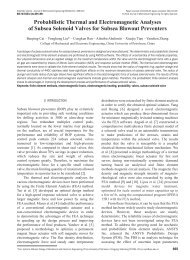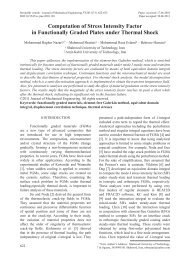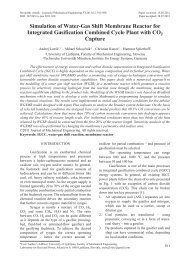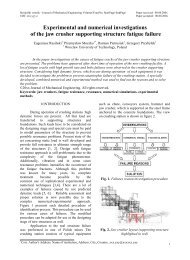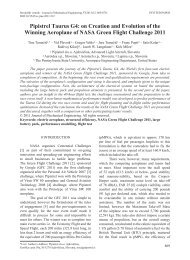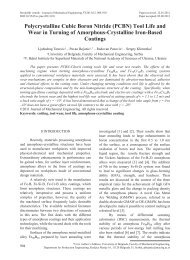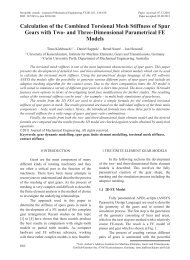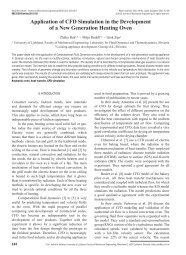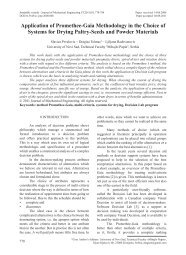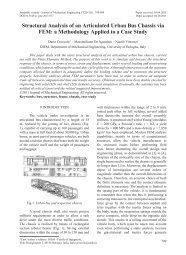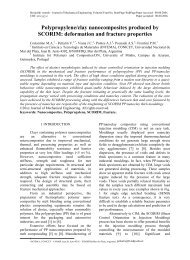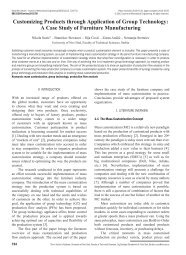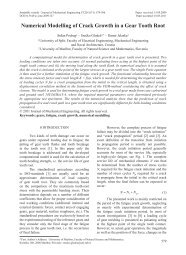Influence of Input Parameters on the Characteristics of the EDM ...
Influence of Input Parameters on the Characteristics of the EDM ...
Influence of Input Parameters on the Characteristics of the EDM ...
- No tags were found...
Create successful ePaper yourself
Turn your PDF publications into a flip-book with our unique Google optimized e-Paper software.
Strojniški vestnik - Journal <str<strong>on</strong>g>of</str<strong>on</strong>g> Mechanical Engineering 57(2011)9, 689-696pulse current has no significant effect <strong>on</strong> <strong>the</strong> depth<str<strong>on</strong>g>of</str<strong>on</strong>g> <strong>the</strong> heat affected z<strong>on</strong>e.4. A slight decrease could be observed in <strong>the</strong>white layer thickness by an increase in <strong>the</strong>pulse current.5. By c<strong>on</strong>stant level <str<strong>on</strong>g>of</str<strong>on</strong>g> discharge energy, highpulse current and low pulse <strong>on</strong>-time leads toa reducti<strong>on</strong> in <strong>the</strong> white layer thickness anddepth <str<strong>on</strong>g>of</str<strong>on</strong>g> heat affected z<strong>on</strong>e <strong>on</strong> <strong>the</strong> surface <str<strong>on</strong>g>of</str<strong>on</strong>g><strong>EDM</strong>ed workpiece.4 ACKNOWLEDGEMENTSFig. 13. HD vs. pulse currentFur<strong>the</strong>rmore, with an increase in <strong>the</strong>pulse current and with a c<strong>on</strong>stant amount <str<strong>on</strong>g>of</str<strong>on</strong>g>pulse <strong>on</strong>-time, causing a sharp rise in <strong>the</strong> averagetemperature <str<strong>on</strong>g>of</str<strong>on</strong>g> <strong>the</strong> plasma channel [15], <strong>the</strong> energygradient increases, which leads to an increasein <strong>the</strong> pressure <str<strong>on</strong>g>of</str<strong>on</strong>g> gap. Therefore, regarding <strong>the</strong>mechanism <str<strong>on</strong>g>of</str<strong>on</strong>g> bulk boiling phenomen<strong>on</strong>, <strong>the</strong>amount <str<strong>on</strong>g>of</str<strong>on</strong>g> molten material, which is ejected from<strong>the</strong> molten puddle at <strong>the</strong> end <str<strong>on</strong>g>of</str<strong>on</strong>g> each discharge,increases and as a result, <strong>the</strong> %PFE increases [16]as <strong>the</strong> reports <str<strong>on</strong>g>of</str<strong>on</strong>g> Maraf<strong>on</strong>a et al. prove [10].3 CONCLUSIONResults from an experimental investigati<strong>on</strong><strong>on</strong> <strong>the</strong> effect <str<strong>on</strong>g>of</str<strong>on</strong>g> machining parameters <strong>on</strong> <strong>EDM</strong>process characteristics have been presented. Theleading c<strong>on</strong>clusi<strong>on</strong>s are as follows:1. The increase in pulse <strong>on</strong>-time leads to anincrease in <strong>the</strong> material removal rate, surfaceroughness, as well <strong>the</strong> white layer thicknessand depth <str<strong>on</strong>g>of</str<strong>on</strong>g> heat affected z<strong>on</strong>e.2. The increase in pulse current leads to a sharpincrease in <strong>the</strong> material removal rate andsurface roughness.3. The tool wear ratio decreases by <strong>the</strong> increase<str<strong>on</strong>g>of</str<strong>on</strong>g> pulse <strong>on</strong>-time, and increases by <strong>the</strong>increase in <strong>the</strong> pulse current.The authors <str<strong>on</strong>g>of</str<strong>on</strong>g> this study are indebted to<strong>the</strong> Razi Metallurgical Laboratory, MetallurgicalLaboratory <str<strong>on</strong>g>of</str<strong>on</strong>g> Sahand University <str<strong>on</strong>g>of</str<strong>on</strong>g> Technology,universal workshop <str<strong>on</strong>g>of</str<strong>on</strong>g> Training Center <str<strong>on</strong>g>of</str<strong>on</strong>g>Iran Tractor Manufacturing Company, andadvance machining workshop <str<strong>on</strong>g>of</str<strong>on</strong>g> ManufacturingEngineering Department <str<strong>on</strong>g>of</str<strong>on</strong>g> University <str<strong>on</strong>g>of</str<strong>on</strong>g> Tabriz.Also, we would like to appreciate <strong>the</strong> help <str<strong>on</strong>g>of</str<strong>on</strong>g>authors Pr<str<strong>on</strong>g>of</str<strong>on</strong>g>essors J. Khalil Allafy, T.B. NavidChakharlu, as well Mr. A. Nejat Ebrahimi for <strong>the</strong>irinvaluable technical support.5 REFERENCES[1] Abu Zeid, O.A. (1997). On <strong>the</strong> effect <str<strong>on</strong>g>of</str<strong>on</strong>g>electro-discharge machining parameters <strong>on</strong><strong>the</strong> fatigue life <str<strong>on</strong>g>of</str<strong>on</strong>g> AISI D6 tool steel. Journal<str<strong>on</strong>g>of</str<strong>on</strong>g> Materials Processing Technology, vol. 68,p. 27-32.[2] Merdan, M.A.E.R., Arnell, R.D. (1991). Thesurface integrity <str<strong>on</strong>g>of</str<strong>on</strong>g> a die steel after electrodischargemachining, 2. residual stressdistributi<strong>on</strong>. Surface Engineering, vol. 7, p.154-158.[3] Castro, G., Fernandez-Vicente, A., Cid, J.(2007). <str<strong>on</strong>g>Influence</str<strong>on</strong>g> <str<strong>on</strong>g>of</str<strong>on</strong>g> <strong>the</strong> nitriding time <strong>on</strong> <strong>the</strong>wear behavior <str<strong>on</strong>g>of</str<strong>on</strong>g> an AISI H13 steel during acrankshaft forging process. Wear, vol. 263, p.1375-1385.[4] Abdullah, A., Shabgard, M.R. (2008). Effect<str<strong>on</strong>g>of</str<strong>on</strong>g> ultras<strong>on</strong>ic vibrati<strong>on</strong> <str<strong>on</strong>g>of</str<strong>on</strong>g> tool <strong>on</strong> electricaldischarge machining <str<strong>on</strong>g>of</str<strong>on</strong>g> cemented tungstencarbide (WC-Co). Internati<strong>on</strong>al Journal <str<strong>on</strong>g>of</str<strong>on</strong>g>Advanced Manufacturing Technology, vol.38, p. 1137-1147.[5] Khan, A.A. (2008). Electrode wear andmaterial removal rate during <strong>EDM</strong> <str<strong>on</strong>g>of</str<strong>on</strong>g>aluminum and mild steel using copper andbrass electrodes. Internati<strong>on</strong>al Journal <str<strong>on</strong>g>of</str<strong>on</strong>g><str<strong>on</strong>g>Influence</str<strong>on</strong>g> <str<strong>on</strong>g>of</str<strong>on</strong>g> <str<strong>on</strong>g>Input</str<strong>on</strong>g> <str<strong>on</strong>g>Parameters</str<strong>on</strong>g> <strong>on</strong> <strong>the</strong> <strong>Characteristics</strong> <str<strong>on</strong>g>of</str<strong>on</strong>g> <strong>the</strong> <strong>EDM</strong> Process695



